Life Cycle Energy Consumption and Carbon Dioxide Emissions of Agricultural Residue Feedstock for Bioenergy
Abstract
:1. Introduction
- taking into account only the collection and transportation of straw (no cultivation stage);
- the mass allocation (the proportion of straw yield to overall biomass yield);
- the economic allocation (the proportion of straw costs to the overall costs of a product and a byproduct).
- to develop a mathematical model for finding the allocation of the total energy inputs and, therefore, the carbon dioxide emissions between grain and straw;
- to determine the energy inputs into the straw formation;
- to compare the mass and energy allocation indicators;
- to explore the impact of energy and the carbon dioxide emissions associated with straw formation on the power generation indicators such as energy-specific costs and specific carbon dioxide emissions;
- to compare energy and the carbon footprint indicators for different pathways of straw utilization: power generation and the substitution of mineral fertilizers.
2. Materials and Methods
2.1. Embodied Energy
2.2. Energy Output Flow
2.3. Carbon Dioxide Emissions
3. Results
3.1. Allocation of Energy Inputs between Grains and Straw
3.2. Energy Input into Straw Formation
3.3. Comparison of Mass and Energy Allocation Indicators
3.4. Power Generation: Energy Specific Costs and Carbon Dioxide Emissions Associated with Straw Formation
- The efficiency ranges from 10% to 40%.
- The relative energy used for straw formation (100 ΔH/LHVs, %) has two meanings: 0% (energy for straw formation is not taken into account) and 40% (maximum possible value for biomass direct-fired power plants).
3.5. Power Generation or Biofertilizer: Energy and Carbon Dioxide Footprint Comparison
4. Conclusions
Author Contributions
Funding
Institutional Review Board Statement
Informed Consent Statement
Data Availability Statement
Acknowledgments
Conflicts of Interest
References
- Giampietro, M.; Ulgiati, S. Integrated Assessment of Large-Scale Biofuel Production. Crit. Rev. Plant Sci. 2005, 24, 365–384. [Google Scholar] [CrossRef]
- Organisation for Economic Co-operation and Development. World Energy Balances 2019; OECD Publishing: Paris, France, 2019. [Google Scholar] [CrossRef]
- Harjanne, A.; Korhonen, J.M. Abandoning the concept of renewable energy. Energy Policy 2019, 127, 330–340. [Google Scholar] [CrossRef] [Green Version]
- Allen, M.; de Coninck, H.; Dube, O.P.; Hoegh-Guldberg, O.; Jacob, D.; Jiang, K.; Revi, A.; Rogelj, J.; Roy, J.; Shindell, D.; et al. Technical summary. In Global Warming of 1.5 °C; Intergovernmental Panel on Climate Change: Geneva, Switzerland, 2018; Available online: https://www.ipcc.ch/site/assets/uploads/sites/2/2019/05/SR15_TS_High_Res.pdf (accessed on 1 February 2021).
- Adoption of the Paris Agreement. FCCC/CP/2015/L.9/Rev.1, Paris, France. 2015. Available online: https://unfccc.int/resource/docs/2015/cop21/eng/l09r01.pdf (accessed on 14 December 2020).
- United Nations. Transforming Our World: The 2030 Agenda for Sustainable Development; United Nations: New York, NY, USA, 2015; Available online: https://sdgs.un.org/2030agenda (accessed on 14 December 2020).
- Climate Analysis Indicator Tool. World Resources Institute. 2015. Available online: https://ledsgp.org/resource/climate-analysis-indicators-tool/?loclang=en_gb (accessed on 14 December 2020).
- A Clean Planet for All: A European Strategic Long-Term Vision for A Prosperous, Modern, Competitive and Climate Neutral Economy. EUR-Lex, Document 52018DC0773; European Commission: Brussels, Belgium, 2018; Available online: https://eur-lex.europa.eu/legal-content/EN/TXT/?uri=CELEX%3A52018DC0773 (accessed on 14 December 2020).
- Svazas, M.; Navickas, V.; Krajnakova, E.; Nakonieczny, J. Sustainable supply chain of the biomass cluster as a factor for preservation and enhancement of forests. J. Int. Stud. 2019, 12, 309–321. [Google Scholar] [CrossRef]
- Popp, J.; Kovács, S.; Oláh, J.; Divéki, Z.; Balázs, E. Bioeconomy: Biomass and biomass-based energy supply and demand. New Biotechnol. 2021, 60, 76–84. [Google Scholar] [CrossRef] [PubMed]
- Hansen, K.; Breyer, C.; Lund, H. Status and perspectives on 100% renewable energy systems. Energy 2019, 175, 471–480. [Google Scholar] [CrossRef]
- REN21. Renewable 2018—Global Status Report; REN21: Paris, France, 2018; Available online: https://www.ren21.net/wp-content/uploads/2019/05/gsr_2019_full_report_en.pdf (accessed on 14 December 2020).
- Jewell, J.; Vinichenko, V.; Nacke, L.; Cherp, A. Prospects for powering past coal. Nat. Clim. Chang. 2019, 9, 592–597. [Google Scholar] [CrossRef]
- Rentier, G.; Lelieveldt, H.; Kramer, G.J. Varieties of coal-fired power phase-out across Europe. Energy Policy 2019, 132, 620–632. [Google Scholar] [CrossRef]
- Fraunholz, C.; Hladik, D.; Keles, D.; Möst, D.; Fichtner, W. On the long-term efficiency of market splitting in Germany. Energy Policy 2021, 149, 111833. [Google Scholar] [CrossRef]
- Directive 2009/28/EC, On the Promotion of the Use of Energy from Renewable Sources and Amending and Subsequently Repealing Directives 2001/77/EC and 2003/30/EC. EUR-Lex, Document 32009L0028; European Commission: Brussels, Belgium, 2015; Available online: https://eur-lex.europa.eu/legal-content/EN/ALL/?uri=CELEX%3A32009L0028 (accessed on 1 February 2021).
- A Framework Strategy for a Resilient Energy Union with a Forward-Looking Climate Change Policy; European Commission: Brussels, Belgium, 2015; Available online: https://eur-lex.europa.eu/legal-content/EN/TXT/?uri=CELEX:52015DC0080 (accessed on 1 February 2021).
- A Policy Framework for Climate and Energy in the Period from 2020 to 2030. EUR-Lex, Document 52014DC0015; European Commission: Brussels, Belgium, 2014; Available online: https://eur-lex.europa.eu/legal-content/EN/TXT/?uri=COM:2014:15:FIN (accessed on 1 February 2021).
- Giuntoli, J.; Agostini, A.; Caserini, S.; Lugato, E.; Baxter, D.; Marelli, L. Climate change impacts of power generation from residual biomass. Biomass Bioenergy 2016, 89, 146–158. [Google Scholar] [CrossRef]
- Elbersen, B.; Startisky, I.; Hengeveld, G.; Schelhaas, M.J.; Naeff, H.; Bottcher, H. Atlas of EU Biomass Potentials. Spatially Detailed and Quantified Overview of EU Biomass Potential Taking into Account the Main Criteria Determining Biomass Availability from Different Sources. 2012. Available online: https://ec.europa.eu/energy/intelligent/projects/sites/iee-projects/files/projects/documents/biomass_futures_atlas_of_technical_and_economic_biomass_potential_en.pdf (accessed on 1 February 2021).
- Lehtveer, M.; Fridahl, M. Managing variable renewables with biomass in the European electricity system: Emission targets and investment preferences. Energy 2020, 213, 118786. [Google Scholar] [CrossRef]
- Sinsel, S.R.; Riemke, R.L.; Hoffmann, V.H. Challenges and solution technologies for the integration of variable renewable energy sources—A review. Renew. Energy 2020, 145, 2271–2285. [Google Scholar] [CrossRef]
- Kluts, I.; Wicke, B.; Leemans, R.; Faaij, A. Sustainability constraints in determining European bioenergy potential: A review of existing studies and steps forward. Renew. Sustain. Energy Rev. 2017, 69, 719–734. [Google Scholar] [CrossRef] [Green Version]
- Shafie, S.M.; Masjuki, H.; Mahlia, T. Life cycle assessment of rice straw-based power generation in Malaysia. Energy 2014, 70, 401–410. [Google Scholar] [CrossRef]
- Shafie, S.; Mahlia, T.; Masjuki, H. Life cycle assessment of rice straw co-firing with coal power generation in Malaysia. Energy 2013, 57, 284–294. [Google Scholar] [CrossRef]
- Sun, Y.; Cai, W.; Chen, B.; Guo, X.; Hu, J.; Jiao, Y. Economic analysis of fuel collection, storage, and transportation in straw power generation in China. Energy 2017, 132, 194–203. [Google Scholar] [CrossRef]
- Chen, Y.; Hu, W.; Feng, Y.; Sweeney, S. Status and prospects of rural biogas development in China. Renew. Sustain. Energy Rev. 2014, 39, 679–685. [Google Scholar] [CrossRef]
- Feng, F.; Song, G.; Shen, L.; Xiao, J. Environmental benefits analysis based on life cycle assessment of rice straw-based synthetic natural gas in China. Energy 2017, 139, 341–349. [Google Scholar] [CrossRef]
- Wang, L.; Littlewood, J.; Murphy, R.J. Environmental sustainability of bioethanol production from wheat straw in the UK. Renew. Sustain. Energy Rev. 2013, 28, 715–725. [Google Scholar] [CrossRef] [Green Version]
- Song, S.; Liu, P.; Xu, J.; Chong, C.; Huang, X.; Ma, L.; Li, Z.; Ni, W. Life cycle assessment and economic evaluation of pellet fuel from corn straw in China: A case study in Jilin Province. Energy 2017, 130, 373–381. [Google Scholar] [CrossRef]
- Lu, W.; Zhang, T. Life-Cycle Implications of Using Crop Residues for Various Energy Demands in China. Environ. Sci. Technol. 2010, 44, 4026–4032. [Google Scholar] [CrossRef] [PubMed]
- Nguyen, T.L.T.; Hermansen, J.E.; Mogensen, L. Environmental performance of crop residues as an energy source for electricity production: The case of wheat straw in Denmark. Appl. Energy 2013, 104, 633–641. [Google Scholar] [CrossRef]
- Hu, J.; Lei, T.; Wang, Z.; Yan, X.; Shi, X.; Li, Z.; He, X.; Zhang, Q. Economic, environmental and social assessment of briquette fuel from agricultural residues in China—A study on flat die briquetting using corn stalk. Energy 2014, 64, 557–566. [Google Scholar] [CrossRef]
- Soam, S.; Borjesson, P.; Sharma, P.K.; Gupta, R.P.; Tuli, D.K.; Kumar, R. Life cycle assessment of rice straw utilization practices in India. Bioresour. Technol. 2017, 228, 89–98. [Google Scholar] [CrossRef] [PubMed]
- Directive (EU) 2018/2001 of the European Parliament and of the Council of 11 December 2018 on the Promotion of the Use of Energy from Renewable Sources (Recast). 2018. Available online: https://eur-lex.europa.eu/legal-content/EN/TXT/PDF/?uri=CELEX:32018L2001&from=EN (accessed on 14 December 2020).
- Jordan, C.F. An Ecosystem Approach to Sustainable Agriculture; Springer: Berlin/Heidelberg, Germany, 2013; ISBN 978-94-007-9717-8. [Google Scholar]
- Jaramillo, P.; Samaras, C.; Wakeley, H.; Meisterling, K.W. Greenhouse gas implications of using coal for transportation: Life cycle assessment of coal-to-liquids, plug-in hybrids, and hydrogen pathways. Energy Policy 2009, 37, 2689–2695. [Google Scholar] [CrossRef]
- De Haes, H.A.U.; Heijungs, R. Life-cycle assessment for energy analysis and management. Appl. Energy 2007, 84, 817–827. [Google Scholar] [CrossRef]
- Lean, H.H.; Smyth, R. CO2 emissions, electricity consumption and output in ASEAN. Appl. Energy 2010, 87, 1858–1864. [Google Scholar] [CrossRef]
- Atkins, M.J.; Morrison, A.S.; Walmsley, M.R. Carbon Emissions Pinch Analysis (CEPA) for emissions reduction in the New Zealand electricity sector. Appl. Energy 2010, 87, 982–987. [Google Scholar] [CrossRef] [Green Version]
- Johansson, T.B.; Nakicenovic, N.; Patwardhan, A.; Gomez-Echeverri, L. Global Energy Assessment; Cambridge University Press: Cambridge, UK, 2012. [Google Scholar] [CrossRef]
- Romanelli, T.L.; Nardi, H.D.S.; Saad, F.A. Material embodiment and energy flows as efficiency indicators of soybean (Glycine max) production in Brazil. Engenharia Agrícola 2012, 32, 261–270. [Google Scholar] [CrossRef] [Green Version]
- Fix, J.; Tynan, S.; Kissinger, M. Carbon Footprint Analysis for Wood & Agricultural Residue Sources of Pulp. Final Report. 2011. Available online: https://www1.agric.gov.ab.ca/$Department/deptdocs.nsf/all/sag13757/$FILE/Final_Report_CFA.pdf (accessed on 14 December 2020).
- Mishra, A.; Kumar, A.; Ghosh, S. Energy assessment of second generation (2G) ethanol production from wheat straw in Indian scenario. 3 Biotech 2018, 8, 142. [Google Scholar] [CrossRef] [PubMed]
- Van Nguyen, H.; Nguyen, C.D.; Van Tran, T.; Hau, H.D.; Nguyen, N.T.; Gummert, M. Energy efficiency, greenhouse gas emissions, and cost of rice straw collection in the mekong river delta of vietnam. Field Crop. Res. 2016, 198, 16–22. [Google Scholar] [CrossRef] [Green Version]
- Said, N.; Alblawai, A.; Hendy, I.; Daiem, M.A. Analysis of Energy and Greenhouse Gas Emissions of Rice Straw to Energy Chain in Egypt. BioResources 2020, 15, 1510–1520. [Google Scholar] [CrossRef]
- Suardi, A.; Bergonzoli, S.; Alfano, V.; Scarfone, A.; Pari, L. Economic Distance to Gather Agricultural Residues from the Field to the Integrated Biomass Logistic Centre: A Spanish Case-Study. Energies 2019, 12, 3086. [Google Scholar] [CrossRef] [Green Version]
- Shang, X.; Song, S.; Yang, J. Comparative Environmental Evaluation of Straw Resources by LCA in China. Adv. Mater. Sci. Eng. 2020, 2020, 1–16. [Google Scholar] [CrossRef] [Green Version]
- Weisser, D. A guide to life-cycle greenhouse gas (GHG) emissions from electric supply technologies. Energy 2007, 32, 1543–1559. [Google Scholar] [CrossRef]
- Ou, X.; Xiaoyu, Y.; Zhang, X. Life-cycle energy consumption and greenhouse gas emissions for electricity generation and supply in China. Appl. Energy 2011, 88, 289–297. [Google Scholar] [CrossRef]
- Liu, B.; Wu, Q.; Wang, F.; Zhang, B. Is straw return-to-field always beneficial? Evidence from an integrated cost-benefit analysis. Energy 2019, 171, 393–402. [Google Scholar] [CrossRef]
- Migo-Sumagang, M.V.P.; Maguyon-Detras, M.C.; Gummert, M.; Alfafara, C.G.; Borines, M.G.; Capunitan, J.A.; Van Hung, N. Rice-Straw-Based Heat Generation System Compared to Open-Field Burning and Soil Incorporation of Rice Straw: An Assessment of Energy, GHG Emissions, and Economic Impacts. Sustainability 2020, 12, 5327. [Google Scholar] [CrossRef]
- Nguyen, V.H.; Topno, S.; Balingbing, C.; Nguyen, V.C.N.; Röder, M.; Quilty, J.; Jamieson, C.; Thornley, P.; Gummert, M. Generating a positive energy balance from using rice straw for anaerobic digestion. Energy Rep. 2016, 2, 117–122. [Google Scholar] [CrossRef]
- Agri-Footprint 2.0 Part 1: Methodology and Basic Principles. 2015. Available online: https://www.agri-footprint.com/wp-content/uploads/2016/08/Agri-footprint-2.0-Part-1-Methodology-and-basic-principles.pdf (accessed on 19 December 2020).
- PRé Consultants. SimaPro Tutorial. 2016. Available online: https://www.pre-sustainability.com/download/SimaPro8Tutorial.pdf (accessed on 1 February 2021).
- Goncharuk, A.G.; Havrysh, V.I.; Nitsenko, V.S. National features for alternative motor fuels market. Int. J. Energy Technol. Policy 2018, 14, 226. [Google Scholar] [CrossRef]
- Kalinichenko, A.; Havrysh, V. Environmentally Friendly Fuel Usage: Economic Margin of Feasibility. Ecol. Chem. Eng. S 2019, 26, 241–254. [Google Scholar] [CrossRef] [Green Version]
- Kalinichenko, A.; Havrysh, V.; Atamanyuk, I. The Acceptable Alternative Vehicle Fuel Price. Energies 2019, 12, 3889. [Google Scholar] [CrossRef] [Green Version]
- Kalinichenko, A.; Havrysh, V.; Hruban, V. Heat Recovery Systems for Agricultural Vehicles: Utilization Ways and Their Efficiency. Agriculture 2018, 8, 199. [Google Scholar] [CrossRef]
- Jiang, Y.; Havrysh, V.; Klymchuk, O.; Nitsenko, V.; Balezentis, T.; Streimikiene, D. Utilization of Crop Residue for Power Generation: The Case of Ukraine. Sustainability 2019, 11, 7004. [Google Scholar] [CrossRef] [Green Version]
- Aguilera, E.; Guzmán, G.I.; Infante-amate, J.; García-ruiz, R.; Herrera, A.; Villa, I. Embodied Energy in Agricultural Inputs. Incorporating a Historical Perspective. DT-SEHA 15. 2015. Available online: http://hdl.handle.net/10234/141278 (accessed on 5 December 2020).
- Skowrońska, M.; Filipek, T. Life cycle assessment of fertilizers: A review. Int. Agrophysics 2014, 28, 101–110. [Google Scholar] [CrossRef]
- Ledgard, S.F.; Boyes, M.; Brentrup, F. Life Cycle Assessment of Local and Imported Fertilisers Used on New Zealand Farms. In Adding to the Knowledge Base for the Nutrient Manager; Massey University: Auckland, New Zealand, 2011; Occasional Report No. 24. Christensen; Available online: https://www.massey.ac.nz/~flrc/workshops/11/Manuscripts/Ledgard_2011.pdf (accessed on 1 February 2021).
- Wood, S.; Cowie, A. A Review of Greenhouse Gas Emission Factors for Fertiliser Production. June 2004. For IEA Bioenergy Task 38. Available online: https://www.sciencetheearth.com/uploads/2/4/6/5/24658156/2004_wood_a_review_of_greenhouse_gas_emission_factors.pdf (accessed on 1 February 2021).
- Veiga, J.P.S.; Romanelli, T.L.; Gimenez, L.M.; Busato, P.; Milan, M. Energy embodiment in Brazilian agriculture: An overview of 23 crops. Sci. Agricola 2015, 72, 471–477. [Google Scholar] [CrossRef]
- Todde, G.; Murgia, L.; Caria, M.; Pazzona, A. A Comprehensive Energy Analysis and Related Carbon Footprint of Dairy Farms, Part 2: Investigation and Modeling of Indirect Energy Requirements. Energies 2018, 11, 463. [Google Scholar] [CrossRef] [Green Version]
- Eriksson, M.; Ahlgren, S. LCAs of Petrol and Diesel—A Literature Review; Swedish University of Agricultural Science: Uppsala, Sweden, 2013; Available online: https://pub.epsilon.slu.se/10424/17/ahlgren_s_and_eriksson_m_130529.pdf (accessed on 1 February 2021).
- Havrysh, V.; Kalinichenko, A.; Mentel, G.; Mentel, U.; Vasbieva, D.G. Husk Energy Supply Systems for Sunflower Oil Mills. Energies 2020, 13, 361. [Google Scholar] [CrossRef] [Green Version]
- Havrysh, V.; Hruban, V.; Sadovoy, O.; Kalinichenko, A.; Taikhrib, K. Sustainable Energy Supply Based on Sunflower Seed Husk for Oil mills. In Proceedings of the International Conference on Modern Electrical and Energy Systems (MEES), Kremenchuk, Ukraine, 23–25 September 2019. [Google Scholar] [CrossRef]
- Bentsen, N.S.; Felby, C.; Thorsen, B.J. Agricultural residue production and potentials for energy and materials services. Prog. Energy Combust. Sci. 2014, 40, 59–73. [Google Scholar] [CrossRef]
- Scarlat, N.; Martinov, M.; Dallemand, J.-F. Assessment of the availability of agricultural crop residues in the European Union: Potential and limitations for bioenergy use. Waste Manag. 2010, 30, 1889–1897. [Google Scholar] [CrossRef] [PubMed]
- Peltonen-Sainio, P.; Muurinen, S.; Rajala, A.; Jauhiainen, L. Variation in harvest index of modern spring barley, oat and wheat cultivars adapted to northern growing conditions. J. Agric. Sci. 2007, 146, 35–47. [Google Scholar] [CrossRef]
- Larsen, S.U.; Bruun, S.; Lindedam, J. Straw yield and saccharification potential for ethanol in cereal species and wheat cultivars. Biomass- Bioenergy 2012, 45, 239–250. [Google Scholar] [CrossRef]
- Cardoen, D.; Joshi, P.; Diels, L.; Sarma, P.M.; Pant, D. Agriculture biomass in India: Part 1. Estimation and characterization. Resour. Conserv. Recycl. 2015, 102, 39–48. [Google Scholar] [CrossRef]
- Geletukha, G.; Zheliezna, T. Prospects for the Use of Agricultural Residue for Energy Production in Ukraine; Position Paper 7; Bioenergy Association of Ukraine: Kyiv, Ukraine, 2014; Available online: https://uabio.org/wp-content/uploads/2020/04/position-paper-uabio-7-en.pdf (accessed on 1 February 2021).
- Ziaei, S.; Mazloumzadeh, S.; Jabbary, M. A comparison of energy use and productivity of wheat and barley (case study). J. Saudi Soc. Agric. Sci. 2015, 14, 19–25. [Google Scholar] [CrossRef] [Green Version]
- Ghorbani, R.; Mondani, F.; Amirmoradi, S.; Feizi, H.; Khorramdel, S.; Teimouri, M.; Sanjani, S.; Anvarkhah, S.; Aghel, H. A case study of energy use and economical analysis of irrigated and dryland wheat production systems. Appl. Energy 2011, 88, 283–288. [Google Scholar] [CrossRef]
- Shahan, S.; Jafari, A.; Mobli, H.; Rafiee, S.; Karimi, M. Energy Use and Economical Analysis of Wheat Production in Iran: A Case Study from Ardabil Province. J. Agricult. Technol. 2008, 4, 77–88. Available online: http://ijat-aatsea.com/pdf/JUNE_v4_n1_08/IJAT2008_07_Karimi.pdf (accessed on 10 January 2021).
- Yildiz, T. An Input-Output Energy Analysis of Wheat Production in Çarşamba District of Samsun Province. J. Agric. Fac. Gaziosmanpasa Univ. 2016, 33, 10–20. [Google Scholar] [CrossRef]
- Kardoni, F.; Parande, S.; Jassemi, K.; Karami, S. Energy Input-output Relationship and Economical Analysis of Wheat Production in Khuzestan Province of Iran. Int. J. Agronom. Plant. Product. 2013, 4, 2187–2193. Available online: https://www.semanticscholar.org/paper/Energy-Input-output-Relationship-and-Economical-of-Kardoni-Parande/be3b7368a7a7a95c0e75b87fe7af45a1a8b2dbf1 (accessed on 10 January 2021).
- Bakht, J.; Shafi, M.; Jan, M.T.; Shah, Z. Influence of crop residue management, cropping system and N fertilizer on soil N and C dynamics and sustainable wheat (Triticum aestivum L.) production. Soil Tillage Res. 2009, 104, 233–240. [Google Scholar] [CrossRef]
- Zhang, X.; Xin, X.; Zhu, A.; Zhang, J.; Yang, W. Effects of tillage and residue managements on organic C accumulation and soil aggregation in a sandy loam soil of the North China Plain. Catena 2017, 156, 176–183. [Google Scholar] [CrossRef]
- Yin, H.; Zhao, W.; Li, T.; Cheng, X.; Liu, Q. Balancing straw returning and chemical fertilizers in China: Role of straw nutrient resources. Renew. Sustain. Energy Rev. 2018, 81, 2695–2702. [Google Scholar] [CrossRef]
- Chen, Y.; Xin, L.; Liu, J.; Yuan, M.; Liu, S.; Jiang, W.; Chen, J. Changes in bacterial community of soil induced by long-term straw returning. Sci. Agricola 2017, 74, 349–356. [Google Scholar] [CrossRef]
- Shan, J.; Yan, X. Effects of crop residue returning on nitrous oxide emissions in agricultural soils. Atmos. Environ. 2013, 71, 170–175. [Google Scholar] [CrossRef]
- Dankevych, L.; Leonova, N.; Dragovoz, I.; Patyka, V.; Kalinichenko, A.; Wlodarczyk, P.; Wlodarczyk, B. The synthesis of plant growth stimulators by phytopathogenic bacteria as factor of pathogenicity. Appl. Ecol. Environ. Res. 2018, 16, 1581–1593. [Google Scholar] [CrossRef]
- Naser, H.M.; Nagata, O.; Tamura, S.; Hatano, R. Methane emissions from five paddy fields with different amounts of rice straw application in central Hokkaido, Japan. Soil Sci. Plant Nutr. 2007, 53, 95–101. [Google Scholar] [CrossRef] [Green Version]
- Zhu, L.; Hu, N.; Yang, M.; Zhan, X.; Zhang, Z. Effects of Different Tillage and Straw Return on Soil Organic Carbon in a Rice-Wheat Rotation System. PLoS ONE 2014, 9, e88900. [Google Scholar] [CrossRef] [PubMed] [Green Version]
- Karlen, D.L.; Kovar, J.L.; Birrell, S.J. Corn Stover Nutrient Removal Estimates for Central Iowa, USA. Sustainability 2015, 7, 8621–8634. [Google Scholar] [CrossRef] [Green Version]
- Kim, S.; Dale, B.E.; Jenkins, R. Life cycle assessment of corn grain and corn stover in the United States. Int. J. Life Cycle Assess. 2009, 14, 160–174. [Google Scholar] [CrossRef]
- Technical Annex to the SEAP: The Emission Factors. Available online: https://www.ces-med.eu/publications/technical-annex-seap (accessed on 2 February 2021).

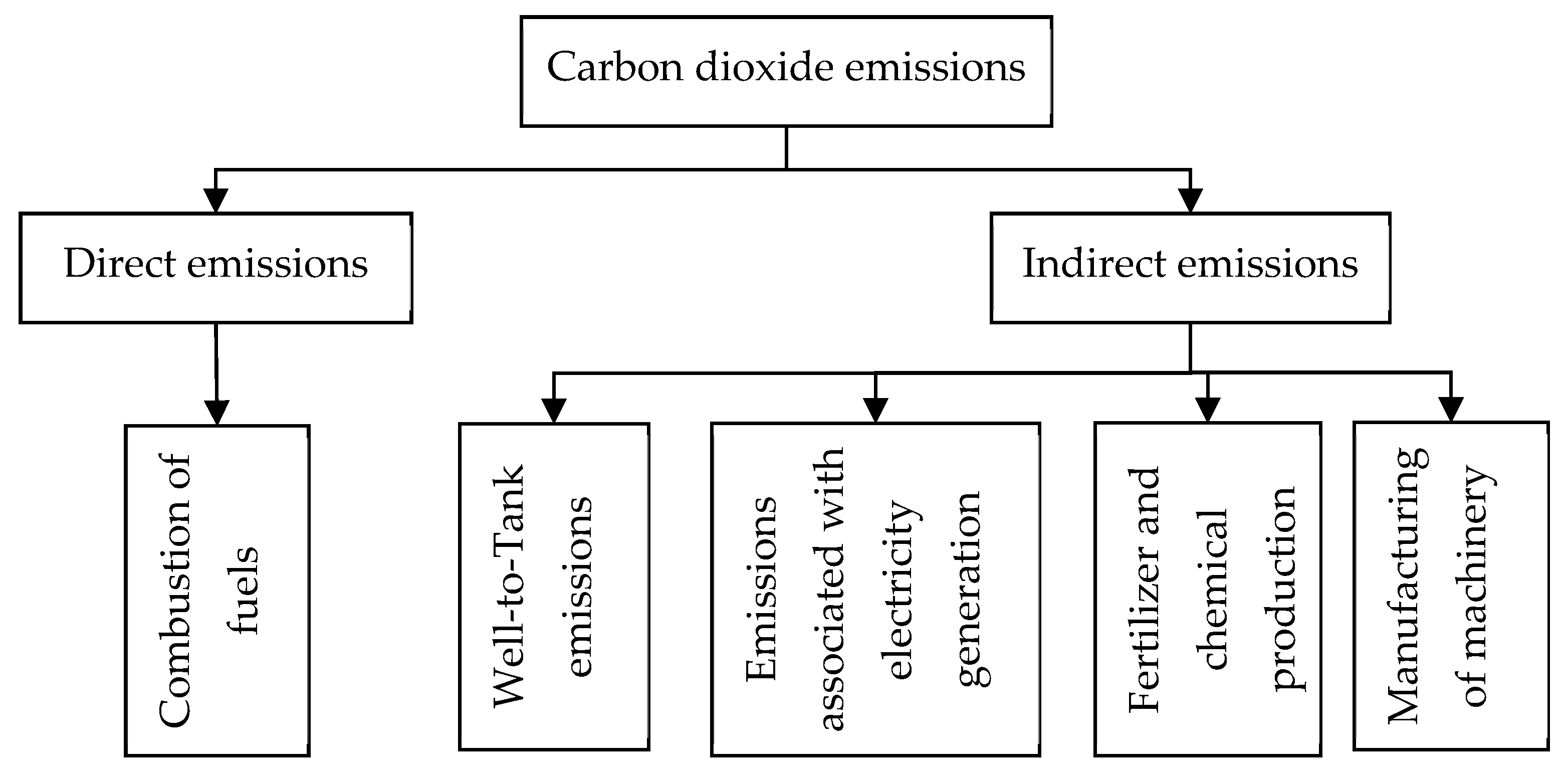
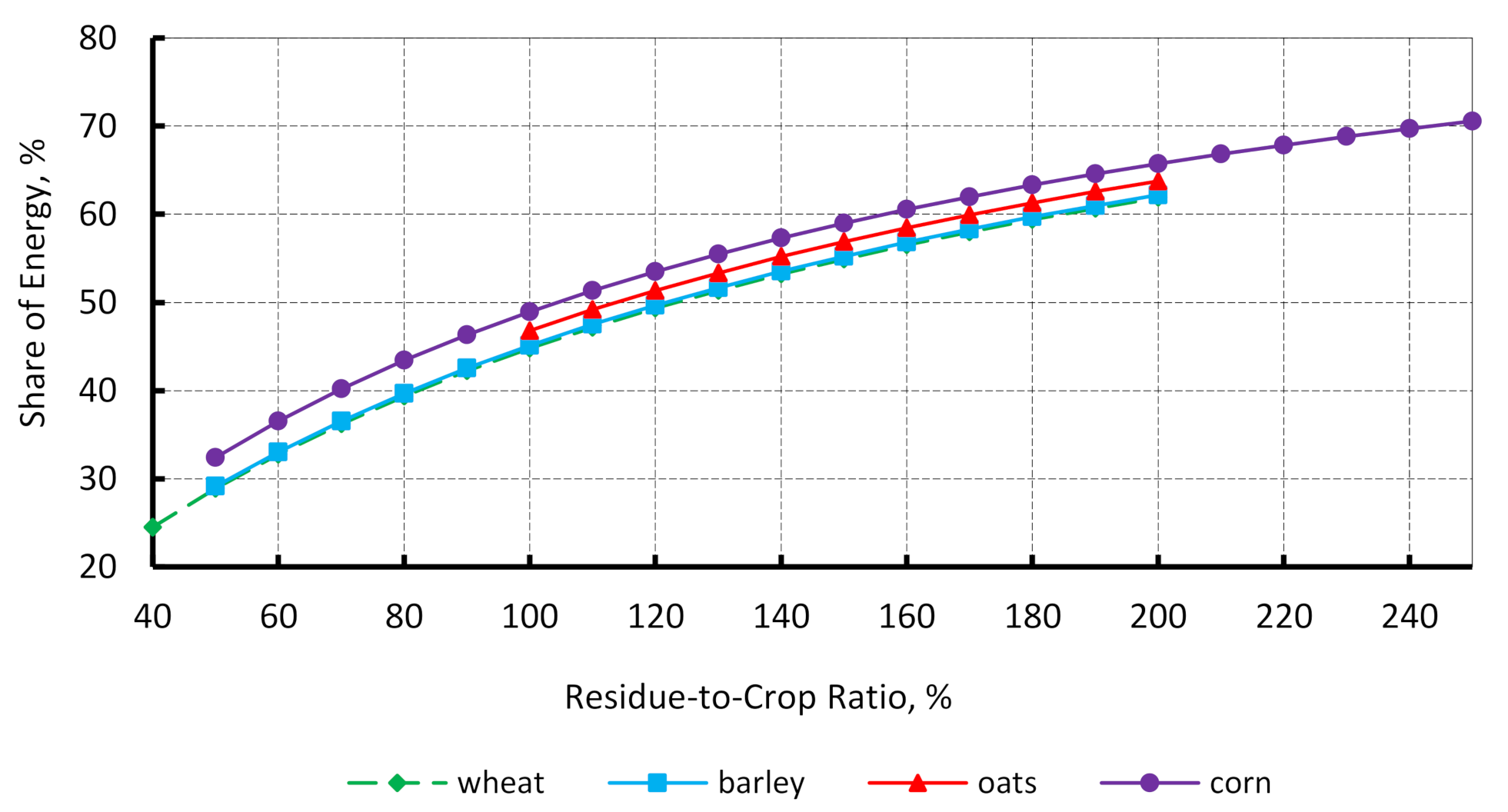
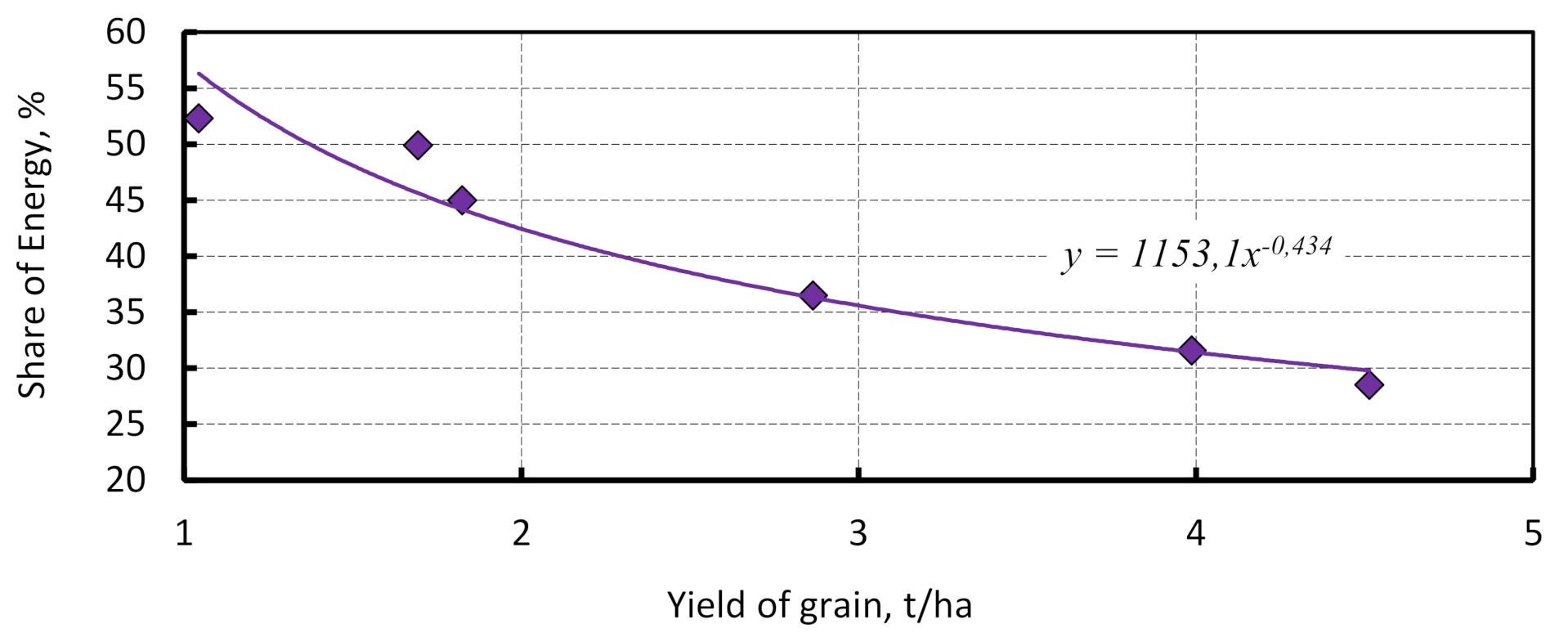
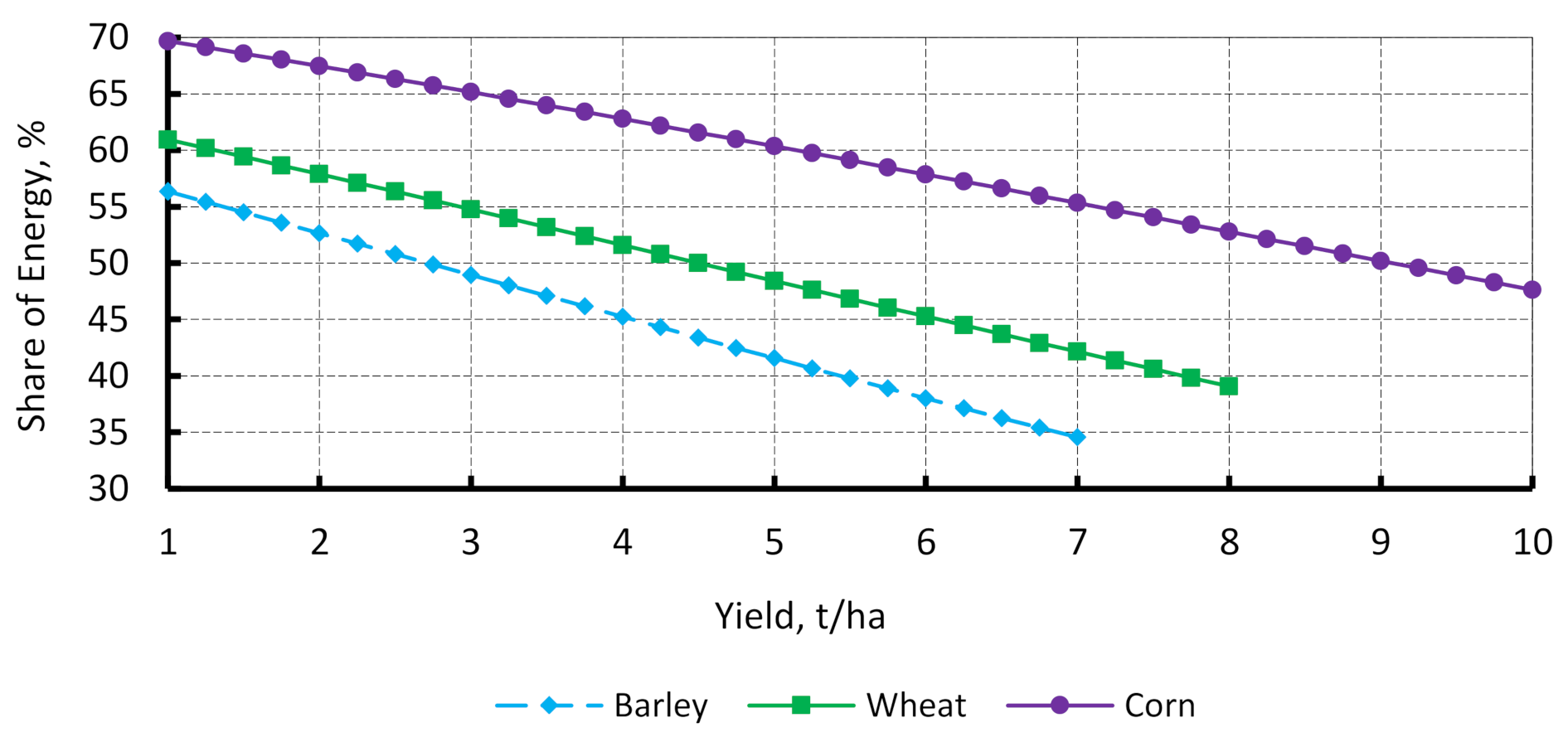

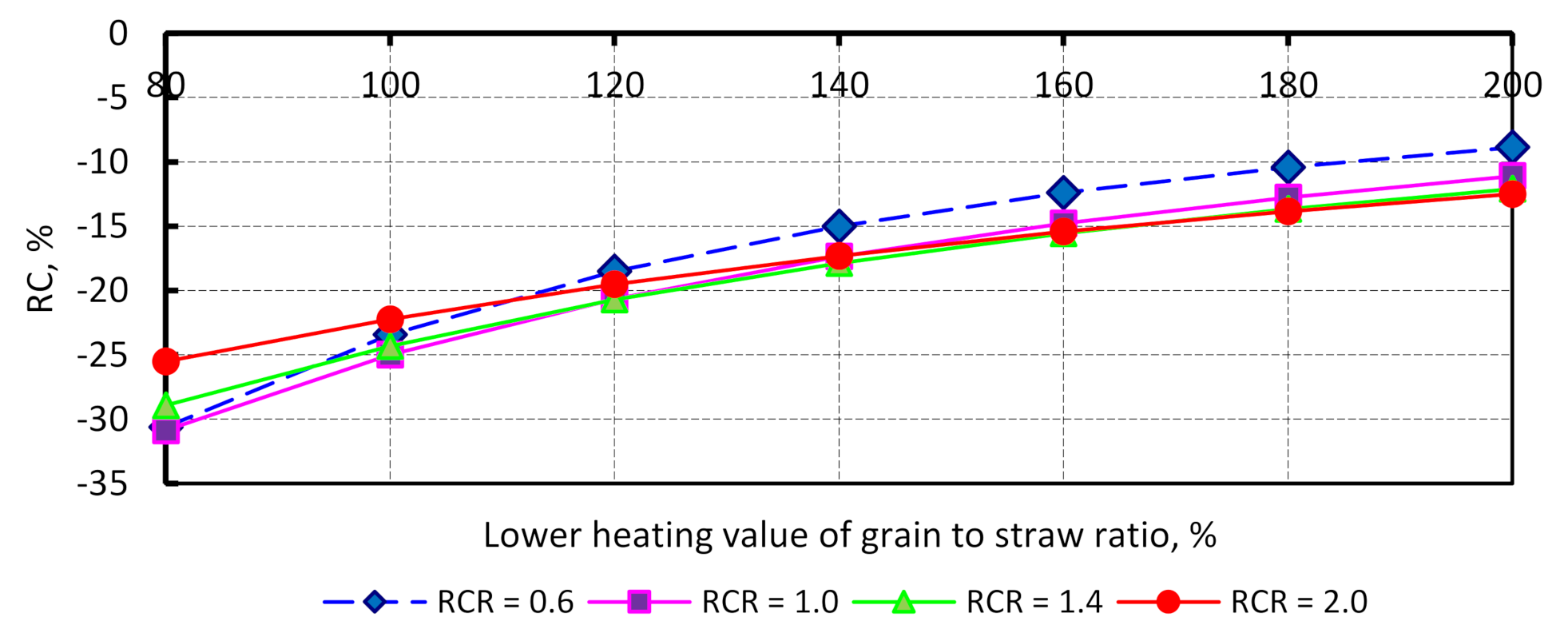

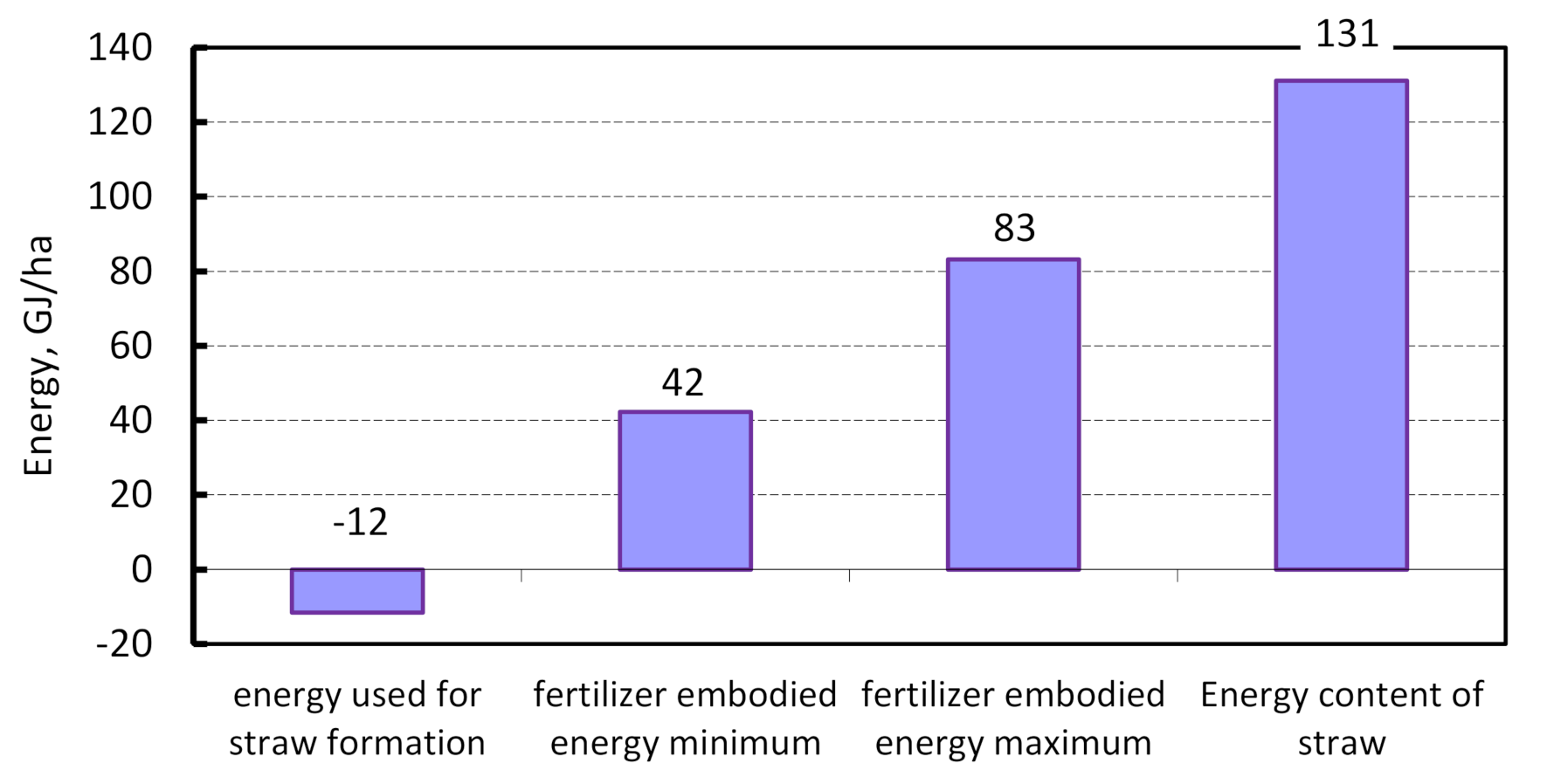
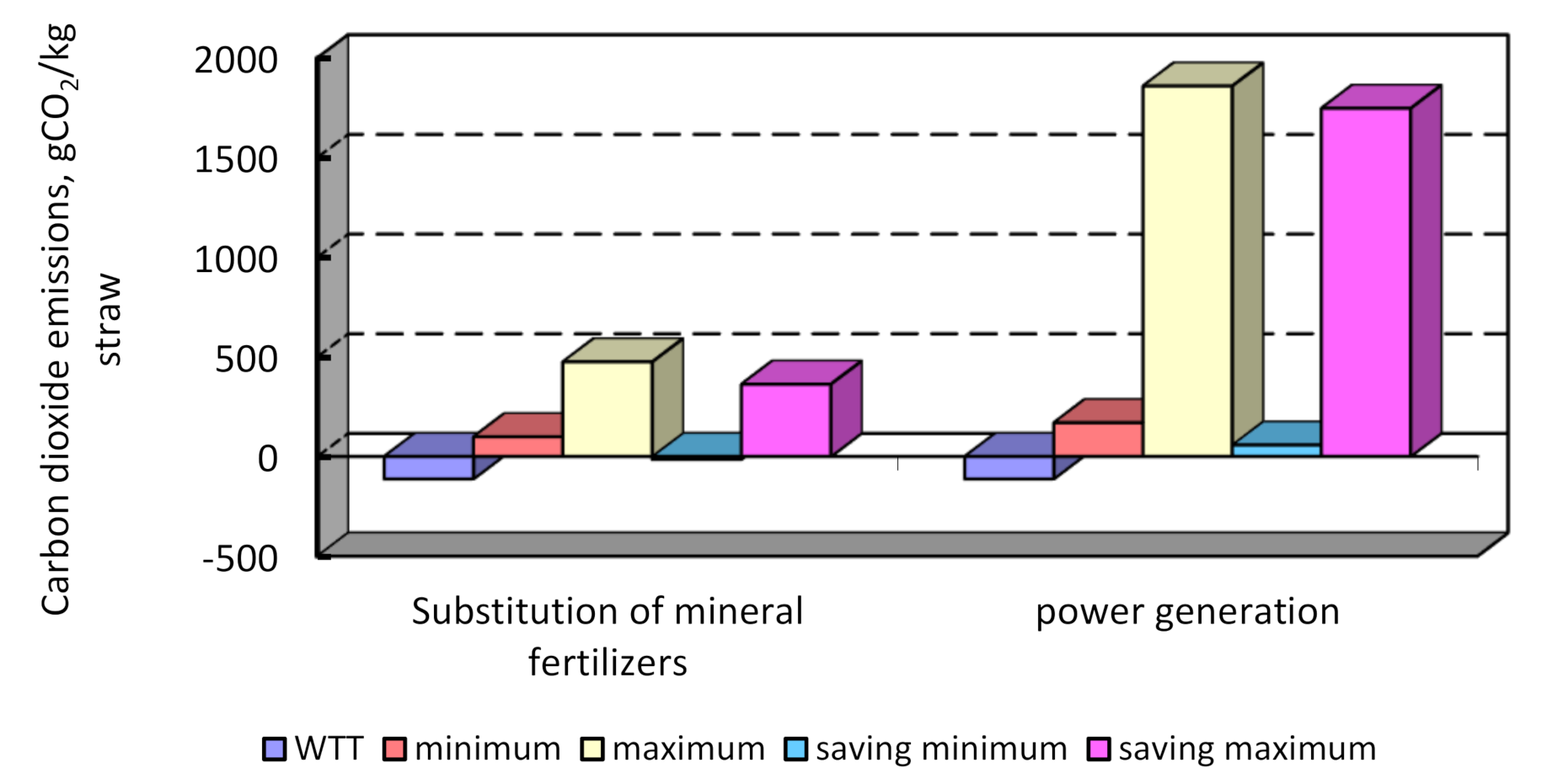

| Input | Unit | Value | Reference |
|---|---|---|---|
| Fuels: | |||
| Diesel fuel | MJ/kg | 56.8 | [61] |
| Petrol | MJ/kg | 60.2 | [61] |
| Natural gas | MJ/kg | 54.6 | [61] |
| Electricity: | |||
| Coal power plant | MJ/MJ MJ/kWh * | 3.14 11.30 | [61] |
| Natural gas power plant | MJ/MJ MJ/kWh * | 2.66 9.36 | [61] |
| Nuclear power plant | MJ/MJ MJ/kWh * | 3.26 11.74 | [61] |
| Hydro power plant | MJ/MJ MJ/kWh * | 1.05 3.78 | [61] |
| Solar power plant | MJ/MJ MJ/kWh * | 1.17 4.21 | [61] |
| Wind power plant | MJ/MJ MJ/kWh * | 1.05 3.78 | [61] |
| Fertilizers: | |||
| Nitrogen | MJ/kg | 52.02–121.21 | [61,62,63,64] |
| P2O5 | MJ/kg | 12.60–63.02 | [61,62,63,64] |
| K2O | MJ/kg | 6.70–16.77 | [61,62,63,64] |
| Manure: | MJ/kg | ||
| Poultry manure | MJ/kg | 0.30 | [61] |
| Cattle manure | MJ/kg | 16.1 | [61] |
| pig | MJ/kg | 19.4 | [61] |
| layer | MJ/kg | 11.9 | [61] |
| broiler | MJ/kg | 17.9 | [61] |
| Chemicals | |||
| Pesticides | MJ/L | 447–820 | [61] |
| Herbicides | MJ/L | 454.20 | [65] |
| Insecticides | MJ/L | 184.20 | [65] |
| Fungicides | MJ/L | 97.10 | [65] |
| Machinery: | |||
| Tractor | MJ/kg | 138 | [61] |
| Implement | MJ/kg | 69 | [66] |
| Crop | Residue-to-Crop Ratio | Lower Heating Value of Straw, MJ/kg | Calorific Value of Grain, MJ/kg |
|---|---|---|---|
| Rapeseed | 1.1–1.7 | 27.7–29.0 | 14.7–19.1 |
| Wheat | 0.8–1.8 | 15.0–18.1 | 13.7–19.1 |
| Rye | 1.7–1.75 | 15.0–18.1 | 13.6–19.1 |
| Oats | 1.0–2.0 | 15.0–18.1 | 12.9–19.1 |
| Barley | 0.9–1.8 | 15.0–18.1 | 13.4–19.1 |
| Corn | 0.7–2.0 | 16.1 | 13.9–14.5 |
| Sunflower | 1.0–3.0 | 16.0 | 25.0 |
| Fertilizer Product | Primary Component | Percentage (by Weight) | Primary Energy Consumption, MJ/kg (Primary Component) | Carbon Dioxide Emissions, g CO2/kg (Primary Component) |
|---|---|---|---|---|
| Ammonium nitrate | N | 33.5 | 90.30–121.21 | 2298–7108 |
| Urea | N | 46 | 52.02–112.17 | 913–4018 |
| Ammonia | N | 82 | 1491–2637 | |
| Single superphosphate | P | 21 | 61.90 | −238–1051 |
| Triple superphosphate | P | 48 | 16.50–63.02 | −416–1083 |
| Potassium chloride | K | 60 | 16.77 | 583 |
Publisher’s Note: MDPI stays neutral with regard to jurisdictional claims in published maps and institutional affiliations. |
© 2021 by the authors. Licensee MDPI, Basel, Switzerland. This article is an open access article distributed under the terms and conditions of the Creative Commons Attribution (CC BY) license (http://creativecommons.org/licenses/by/4.0/).
Share and Cite
Havrysh, V.; Kalinichenko, A.; Brzozowska, A.; Stebila, J. Life Cycle Energy Consumption and Carbon Dioxide Emissions of Agricultural Residue Feedstock for Bioenergy. Appl. Sci. 2021, 11, 2009. https://doi.org/10.3390/app11052009
Havrysh V, Kalinichenko A, Brzozowska A, Stebila J. Life Cycle Energy Consumption and Carbon Dioxide Emissions of Agricultural Residue Feedstock for Bioenergy. Applied Sciences. 2021; 11(5):2009. https://doi.org/10.3390/app11052009
Chicago/Turabian StyleHavrysh, Valerii, Antonina Kalinichenko, Anna Brzozowska, and Jan Stebila. 2021. "Life Cycle Energy Consumption and Carbon Dioxide Emissions of Agricultural Residue Feedstock for Bioenergy" Applied Sciences 11, no. 5: 2009. https://doi.org/10.3390/app11052009
APA StyleHavrysh, V., Kalinichenko, A., Brzozowska, A., & Stebila, J. (2021). Life Cycle Energy Consumption and Carbon Dioxide Emissions of Agricultural Residue Feedstock for Bioenergy. Applied Sciences, 11(5), 2009. https://doi.org/10.3390/app11052009








